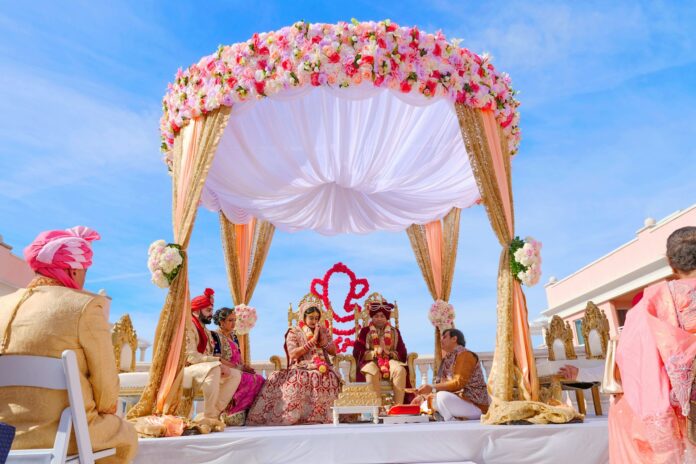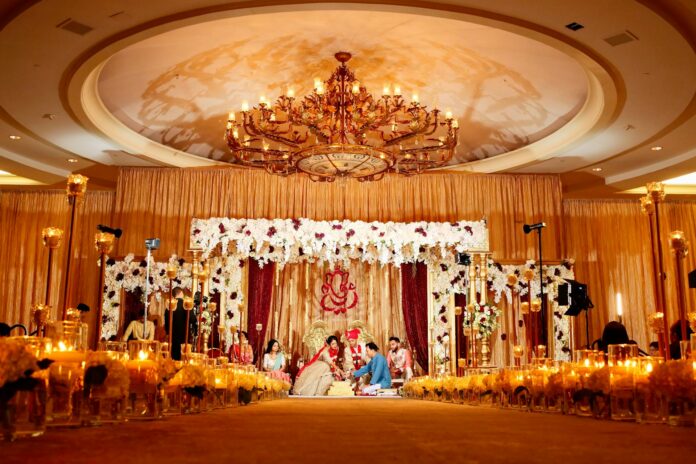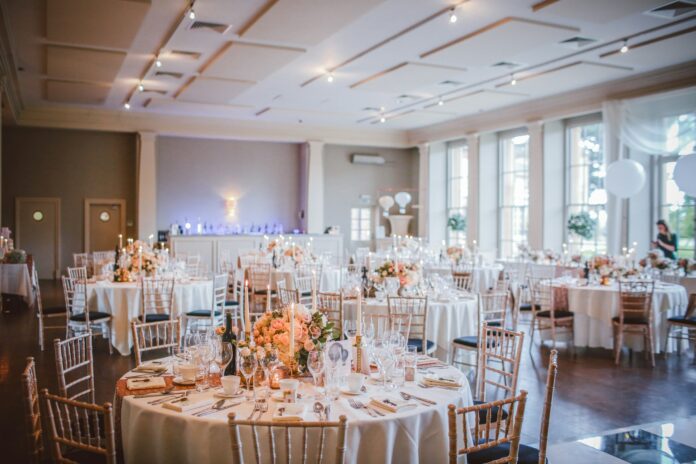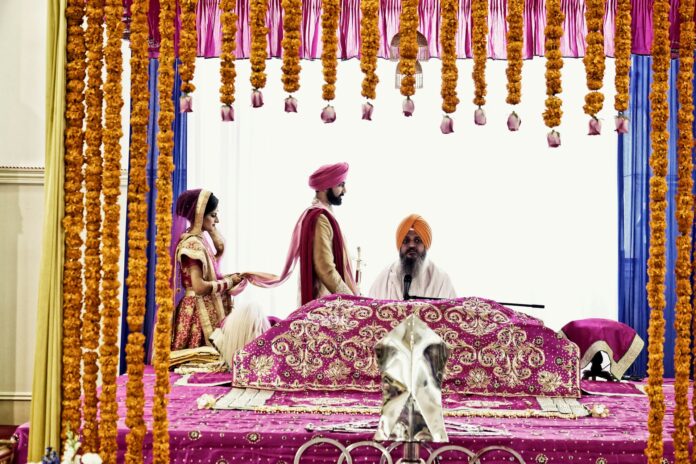
An Indian wedding is a vibrant expression of rich culture told through elaborate rituals, cuisine, attire and symbolic décor. Steeped in tradition, Indian weddings typically employ décor palettes with culturally significant colours that herald prosperity and new beginnings for the couple. Beyond catering to current trends, the thoughtful inclusion of auspicious wedding colour schemes deeply ingrained in regional heritage helps summon the blessings of ancestors’ past.
From high-energy mehndis to intimate home blessings, this article explores traditional wedding event colour schemes as they relate to various Indian communities and religious affiliations. Come discover how the radiant hues adorning couples on their big day hold profound meaning when thoughtfully included by wedding planners, families and newlyweds themselves!
Red – The Quintessential Wedding Shade
No colour more universally symbolises bridal outfits and wedding stages across India than vibrant red. In Hindu culture, red represents power, strength and shakti – the sacred feminine energy present when invoking the goddesses Lakshmi and Durga.
Red saris and lehengas not only proclaim bridal beauty, but they also ward off evil spirits coveting her marital bliss on the vulnerable wedding day. Red envelopes given with monetary wedding gifts are likewise seen as protecting newlyweds from harm.
From Balinese to Chinese cultures, red also signifies luck, long life and love – all revered aspects of starting one’s journey as a couple. Look to incorporate red through floral garlands, luxe decor elements, table runners and traditional Indian Wedding Cards painted or imprinted with the vibrant hue.

Green and the Concept of Rebirth
In Eastern cultures, green symbolises new beginnings and the renewal of hopes – apt sentiments for starting matrimony. Vibrant green also represents fertility and harmony – both desired within marriage.
During sacred Bengali and Tamil wedding rituals, green bangles called ponakkam adorn new brides symbolising prosperity. Green motifs incorporated into Indian Christian wedding cards likewise symbolise bounty and unity in the next chapter of couples’ lives.
Consider fresh green accents through centrepieces blooming with lush ferns, emeralds, roses or orchids to pronounce new beginnings. Lush garlands posted at entrances continue the theme of welcoming guests to enjoy the fruitful ceremony.
Gold & Yellow Tones – Heat of the Blessings
The natural shine of gold needs no introduction as a keystone shade bringing light and opulence to Indian wedding palettes. In Hinduism, gold corresponds with the warmth of divine blessings bestowed through the auspicious occasion unto newlyweds about to circumnavigate the sacred fire seven times. Gold ribbon trim, charger plates and cutlery infuse décor with this radiant blessing.
Similarly, vibrant yellow conveys positive vibes for couples starting their journey together, hoping to stay happy and beaming through their life as partners. Visualising sunshine itself, a wedding awash in yellow represents joy and lighthearted spirit couples strive to carry into challenging times together. Hang strings of tiny golden bells to audibly pronounce blessings as guests arrive.

Blue for Peace
Calming blue holds universal appeal for its peaceful essence. For Indian Hindu and Christian ceremonies, different shades of blue foster tranquillity and harmony suitable for holy matrimonial spaces. From powder blue uplifting the spirit to deeper shades reminiscent of Lord Krishna, blue creates a soothing foundation and the couple can build decades of partnership.
Accent with blue-hued flowers like hydrangea, delphinium, pansies or iris flowers in centrepieces. Drape dreamy blue ribbons along aisles or place azure votive candles throughout venues to pronounce couples’ prayers for lifelong peace.
Pink Blossoms with Playfulness & Purity
Pretty in pink decor fittingly expresses communities celebrating the bride herself through elements like dance, beauty rituals and ornamental outfits. Lighter pink tones suggest the sweetness, hope and new promise carried into marriage.
Deep fuchsia pink arrangements traditionally decorate Punjabi pre-wedding Ladies Sangeet nights filled with feminine music and Revelry. Pink rose garlands dignify the bride as goddess Kanya during auspicious Haldi rituals beseeching future happiness. Blush organza sarees donned for Pellikuthuru ceremonies likewise wish newly married pairs a rosy life ahead.
In this way, pink conveys both joy and purpose when thoughtfully incorporated by considerate wedding planners.

Creative Expression Through Colour
Beyond the well-known red and gold tropes, a colourful Indian wedding at once follows tradition while allowing for creative liberties. Couples may thoughtfully express their personalities or wedding visions through more unique palettes.
Maybe blue accents honour the bride’s birth heritage near sparkling Mediterranean beaches. The emerald green saree pronouncing fortune came directly from the grandmother herself. Or perhaps the fuchsia pink roses bedecking the mandap echo the specific romantic proposal hue.
Decode the Colors ─ Auspicious Hues for Wedding Occasions
Vibrant hues permeating Indian wedding celebrations are far from random. Each shade has traditionally symbolised blessings, hopes and divine protection for couples tying the sacred knot. The colours chosen for various events hold deep cultural meaning:
- Haldi ceremony ─ Vibrant yellows in flowers, fabrics, and turmeric pastes summon blessings of health and prosperity, preparing brides as embodiments of the radiant goddess. In Hindu culture, Haldi ceremonies specifically summon Kanya Kumari – the radiant goddess of fertility and guardian of brides transitioning from daughter to wife.
- Mehandi ─ Lush greens and vibrant henna patterns signify awakening beauty, creativity and fertility as ceremonial markings believed to cool the nervous bride. The rich black-green palette of mehandi paste and playful paisley patterns peaked during festive mehandi nights beautifully pronouncing themes of awakening creativity, beauty, and even fertility for the bride-to-be.
- Sangeet ─ The Ladies’ Sangeet is one of the most joy-filled and beloved pre-wedding traditions – an evening devoted solely to playful female bonding, song and showering blessings onto the bride. Playful shades of fuchsia and peach welcome the sweetness of pre-wedding revelry filled with music, feminine energy and blessing onto the bride-to-be.
- Wedding Day ─ Bridal lehengas and sarees of timeless red proclaim the bride’s strength – the very colour wards off meddling spirits. Grooms don regal sherwanis embroidered with gold accents indicating divine blessings onto the newlyweds. Red outfits boldly summon the Goddess Durga’s fiery strength in protecting newlyweds from jealous gazes or meddling intrigues. Therefore, consider accenting wedding stages with scarlet roses plus golden marigolds indicating the couple’s supported strength.
Accent your Indian wedding with colours holding symbolic meaning for your family’s lineage or regional community. But also fearlessly weave in custom shades paralleling your love story thus far. Strike a thoughtful balance between time-honoured tradition and creative expression when illuminating your once-in-a-lifetime event.











